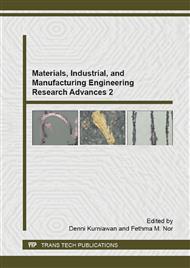p.245
p.250
p.255
p.260
p.266
p.271
p.276
p.281
p.286
Characterization of Nanosilica of Tapioca Peel as Adsorbent for Biomethane Storage System
Abstract:
Biomethane is an alternative and renewable source that occurred naturally which produced from the anaerobic digestion of organic matter. It can be used as the electricity power generation, water heating and also vehicle fuel. In this study, the characteristics of the nanosilica of the tapioca peel as an adsorbent on the structural and physical properties to store the biomethane were investigated. To enhance the adsorption and desorption performance as well as the structural and physical properties, the nanosilica was modified with the metal oxides. The metal oxides that have been used to modify the nanosilica adsorbent are zinc (II) oxide (ZnO) and nickel (II) oxide (NiO). Both of the modified and unmodified nanosilica structural properties were characterized by using X-Ray Diffraction (XRD) and Scanning Electron Microscope (SEM). While, the physical properties of both of the modified and unmodified nanosilica were characterized by using Brunauer, Emmet, Teller (BET) surface area measurement. The effects of both types of metal oxides with different concentration were investigated. Based on the results obtained, the structural and physical characteristics of the nanosilica were affected by the different metal oxides loading. It have been identified that 1% ZnO modified nanosilica has highest BET surface area (8.32 m2/g) with pore volume (19.23 cc/g) and pore size (82.8 nm). Thus, it concluded that 1% ZnO modified nanosilica improved the structural and physical structure. Hence, it enhances the capacity of methane adsorption and desorption prior to storage system.
Info:
Periodical:
Pages:
266-270
Citation:
Online since:
October 2015
Keywords:
Price:
Сopyright:
© 2015 Trans Tech Publications Ltd. All Rights Reserved
Share:
Citation:


